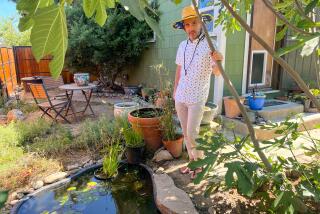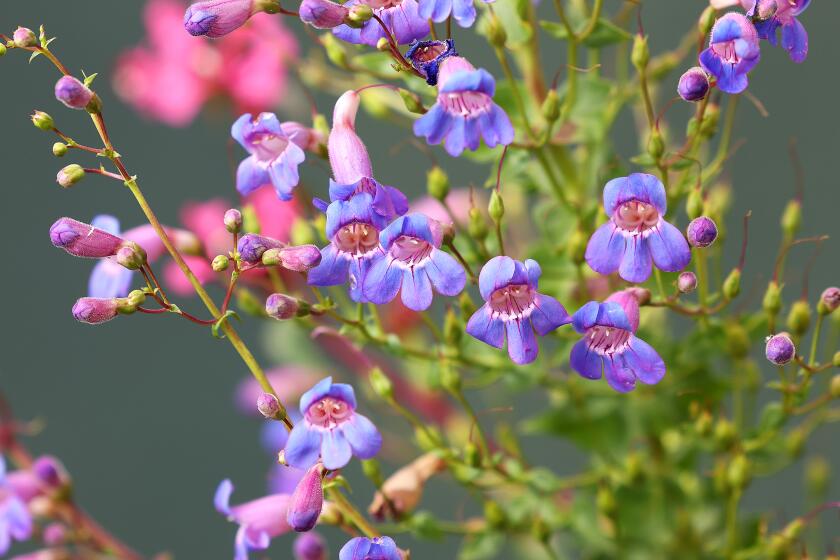Delivering Water by Irrigation Is Always Good to the Last Drip
- Share via
The gardener who can do a thorough job of watering with hose in hand is a rare bird indeed.
Every square foot of garden needs about half a gallon of water at each watering, so to water this way you would have to keep the hose fixed on one area for two minutes (assuming an average four-foot diameter circle wetted and three gallons per minute coming out the end of the hose).
Only after two minutes in one place could you move on to water the next four-foot circle. Pretty boring.
An automatic sprinkler would work better--but best would be drip irrigation, which is a method of applying water to plants slowly and over an extended period of time.
A primitive drip irrigation system could be improvised by running water through an old garden hose whose end is plugged and which is riddled with holes throughout its length.
The problem with this is that water would not seep out evenly along the length of the hose, especially if the hose were long or not level.
Let’s look at the components of a typical commercially manufactured drip irrigation system, starting at the end where the water comes out.
Water emitters are of two basic types: porous tubing and spot emitters.
Porous tubing is much like the old garden hose alluded to above. The better types have a-tube-within-a-tube design, so they are little affected by pressure changes from one end of the tube to the other, or by changes in elevation.
Spot emitters look like small, black pillboxes and plug into holes punched at intervals along half-inch plastic pipe. These emitters are pre-calibrated to drip at a specified rate, usually from one to four gallons per hour.
The best emitters have ingeniously designed innards that make the drip rate immune to changes in water pressure, and the openings are not prone to being clogged by particles in the water.
For plants such as carrots, which grow right next to each other all along the row, you could use porous tubing, or you could spot emitters whose wetting circles in the soil overlap.
The size of the circle wetted by a spot emitter depends on the soil type.
Water dripping onto a sandy soil will spread to form a wet circle about three feet in diameter. Similarly, water will spread laterally between lengths of porous tubing spaced about three feet apart in sandy soils, or six feet apart in clay soils.
For individual plants such as tomatoes, small shrubs and trees, figure on one--or possibly two--spot emitters next to each plant.
Spot emitters that come attached to the ends of thin flexible tubes are used to water plants in pots.
With emitters, tubes and connecting hoses in place, we are now back at the hose spigot.
Before a connection is made to the spigot, a pressure reducer and filter are needed. Drip irrigation works at low water pressure, usually about 10 pounds per square inch. The pressure reducer maintains a constant, low pressure in the drip lines.
Attach the filter to your spigot, and you are ready to water.
The biggest advantage of drip irrigation is that it drastically cuts water use, typically by 60% or more.
The aim of drip irrigation is to replenish water almost as gradually as plants drink it up.
Conventional watering with a sprinkler, in contrast, leaves the soil periodically too wet or too dry. And if you tried to avoid this by sprinkling every day to just replenish the water used, the continually damp leaves would encourage plant diseases.
Drip irrigation puts water where it is needed, without loss from wind or evaporation.
Only your tomatoes or your roses or your blueberries get the water, not the paths between the rows or the weeds between the plants.






